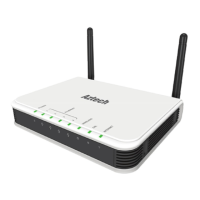
Do you have a question about the Aztech 4-Port Wireless G Router and is the answer not in the manual?
| Connectivity Technology | Wireless |
|---|---|
| Number of Ports | 4 |
| Frequency Band | 2.4GHz |
| Maximum Wireless Speed | 54 Mbps |
| Security | WEP, WPA, WPA2 |
| Wireless Standard | 802.11g |
| Standards | IEEE 802.11g |
| Antenna | External |
| Wireless Data Rates | 54, 48, 36, 24, 18, 12, 9, 6 Mbps |
| Ports | 4 x 10/100M LAN Ports, 1 x 10/100M WAN Port |
Lists the minimum software and hardware specifications needed to use the router.
Details the items included in the router's packaging for user verification.
Describes the physical appearance and LED indicators on the front panel of the router.
Details the ports and buttons located on the back of the router.
Guides users on creating a network diagram to identify devices and plan connections.
Instructions on removing or disabling software that may interfere with router installation.
Provides step-by-step instructions for physically connecting the router and its components.
Details the two methods (Web Interface, Utility Wizard) for establishing an internet connection.
Explains how to open and log into the router's web-based administration interface.
Describes the key elements of the web interface, including buttons, commands, and menus.
Provides a summary of connection, router, local network, and wireless network settings.
Enables users to quickly establish an internet connection with the router.
Allows configuration of settings for each LAN group, including IP address and DHCP.
Tools to test router connectivity and diagnose network issues, including Ping and Full Modem tests.
Configuration options for establishing an internet connection via various WAN types.
Details on configuring LAN groups, IP addresses, and DHCP settings for local networks.
Configuration for various network applications like UPnP, SNTP, SNMP, and DNS Proxy.
Allows configuration of network traffic prioritization for voice and video services.
Settings for static and dynamic routing to manage network traffic pathways.
Secures the web interface by setting an administrator password and idle timeout.
Instructions on updating the router's firmware to the latest version.
Resets the router to its original factory default configuration settings.
Configures the wireless network name (SSID) and enables/disables the Access Point.
Advanced wireless settings for beacon period, RTS/Frag thresholds, and country string.
Allows setting up a primary and a secondary wireless network name (SSID).
Enforces security to prevent unauthorized wireless users from accessing the router.
Manages wireless devices by permitting or banning them using MAC addresses.
Configures WDS for interconnecting access points to build a premise-wide wireless network.
Blocks specific applications/services based on the IP address of LAN devices.
Disables packet flow between two LAN groups for enhanced security.
Blocks access to websites by examining URLs for blocked keywords.
Displays WAN IP, connection state, and duration of the internet connection.
Shows router logs, which can be sent to a remote host if remote logging is enabled.
Forwards logged information to a remote computer, specifying log level and destination.
Shows Ethernet and DSL line statuses and packet statistics.
Displays the WAN connection status for Dynamic DNS updates.
Shows MAC address, IP address, hostname, and lease time for connected DHCP clients.
Displays Quality of Service and packet statistics for network traffic.
Shows the model status, including DSL line parameters and statistics.
Displays product details, hardware information, and software versions.
Displays WDS-related wireless activities, including configuration, states, and statistics.